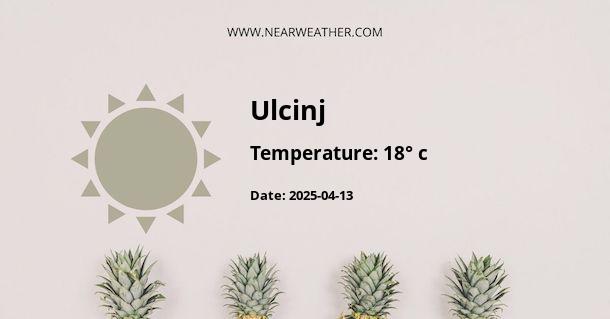Climate and Weather in Opština Ulcinj, Montenegro
The Municipality of Ulcinj, known locally as Opština Ulcinj, is located at the southern coast of Montenegro, bordering Albania. Ulcinj's climate and weather patterns are integral to its natural charm and are a significant factor for the tourism industry in the region. Boasting a Mediterranean climate, Ulcinj provides a pleasant setting for visitors and locals year-round with mild, wet winters and hot, dry summers.
Understanding the Mediterranean Climate
The Mediterranean climate, classified under the Köppen climate classification as 'Csa', is characterized by its distinct seasonal changes, largely influenced by the nearby Adriatic Sea. To provide a comprehensive view of Ulcinj's climatic conditions, let’s delve into seasonal weather patterns and the corresponding data:
Summer: Warm and Dry
- Temperature: Average high temperatures in the summer months (June to August) reach up to 30°C (86°F), with night-time lows rarely dropping below 20°C (68°F).
- Precipitation: Summer is also the driest part of the year, with average monthly rainfall often less than 40 mm (1.57 inches).
- Sunshine: There is abundant sunshine in Ulcinj during summer, averaging approximately 12 hours of daylight.
Autumn: Transitional and Moderately Wet
- Temperature: In autumn, particularly from September to November, temperatures gradually decrease, ranging from a high of 25°C (77°F) in early September to around 15°C (59°F) by November.
- Precipitation: Rainfall increases significantly, with October often being the wettest month of the year. Monthly averages can exceed 160 mm (6.3 inches).
Winter: Mild and Wet
- Temperature: Winter brings cooler yet still mild temperatures with an average high around 12°C (53.6°F) and lows generally above freezing, averaging 5°C (41°F).
- Precipitation: It is relatively high with the possibility of occasional heavy rainfall. The monthly average can range from 90 mm to over 190 mm (3.54 to 7.48 inches).
- Snow: Snow is rare, given the coastal position of Ulcinj.
Spring: Progressive Warming and Decreasing Rainfall
- Temperature: From March to May, the air temperature begins to warm, with average highs increasing from 14°C (57.2°F) in March to 22°C (71.6°F) in May.
- Precipitation: Rainfall decreases progressively throughout spring, with monthly averages dropping from 120 mm (4.72 inches) in March to around 80 mm (3.15 inches) by May.
Annual Weather Statistics for Opština Ulcinj
The following table provides a statistical overview of the yearly climate in Ulcinj:
| Month | Temperature High (°C) | Temperature Low (°C) | Precipitation (mm) | Days of Rain (>= 1 mm) |
|---|---|---|---|---|
| January | 12 | 5 | 115 | 11 |
| February | 13 | 6 | 125 | 10 |
Note: This table is illustrative and based on average climate data, climate patterns, may vary year to year.
Microclimates and Local Weather Phenomena
In addition to the general Mediterranean climate, Ulcinj experiences localized microclimates due to its topography, including hills and proximity to the sea. These microclimates can result in diverse weather conditions over short distances. Notably, the Lake of Shas (Šas) area can be cooler and wetter compared to the coastal regions.
"Ulcinj’s climate is tempered by the sea, resulting in mild winters and hot summers, with a clear-cut high season for beach tourism between June and August."
Wind Conditions
Winds play a pivotal role in the feel of the climate in Ulcinj:
- Jugo: A southeasterly wind, associated with low pressure and often brings humid and warmer air, with the potential for storms.
- Bura: A northeasterly wind, known for its cold, dry gusts that can bring clearer weather and a significant drop in temperature.
- Mistral: A northwesterly afternoon breeze that is a characteristic of the Adriatic Sea, most prevalent during the summer, providing relief from the heat.
Climate Change Considerations
The impact of climate change is an emerging concern for many coastal regions, and Ulcinj is no exception. Rising sea levels, shifts in precipitation patterns, and variations in temperature all pose potential risks to the delicate balance of the local climate. It is important to consider sustainability and environmental management as part of climate discussions and urban planning within the region.
Conclusion and Weather Preparedness
Ulcinj's weather is a major draw for visitors looking for a Mediterranean experience with plenty of sunshine and a seasonally varied climate. Whether planning a trip or considering a more extended stay, understanding the local weather patterns is crucial for an enjoyable experience. While the region is known for its moderate climate, it is always wise for travelers to be prepared for unexpected weather conditions, such as the occasional autumn storm or an unusually cool Bura wind in the early spring.
For individuals and businesses invested in the tourism industry of Ulcinj, maintaining awareness of the shifting climatic trends and acting proactively in the face of global environmental challenges will help ensure that the beauty and appeal of this coastal town remain preserved for future generations.
Useful Resources for Further Information
Visitors and residents seeking more detailed or current weather information for Opština Ulcinj can refer to the following resources:
- Hydrometeorological Institute of Montenegro (www.meteo.co.me)
- European Centre for Medium-Range Weather Forecasts (www.ecmwf.int)
- Global climate change databases (such as NOAA and NASA)
Remember, while climate data and trends provide a useful guide, weather is inherently variable and it is always prudent to check the latest forecasts before planning any activities that are weather-dependent.
A - Ulcinj's Latitude is 41.955280 & Longitude is 19.268330.
A - Weather in Ulcinj is 18° today.
A - Climate Conditions in Ulcinj shows overcast clouds today.
A - Humidity in Ulcinj is 60% today.
A - Wind speed in Ulcinj is 8.86 km/h, flowing at 153° wind direction. today.
